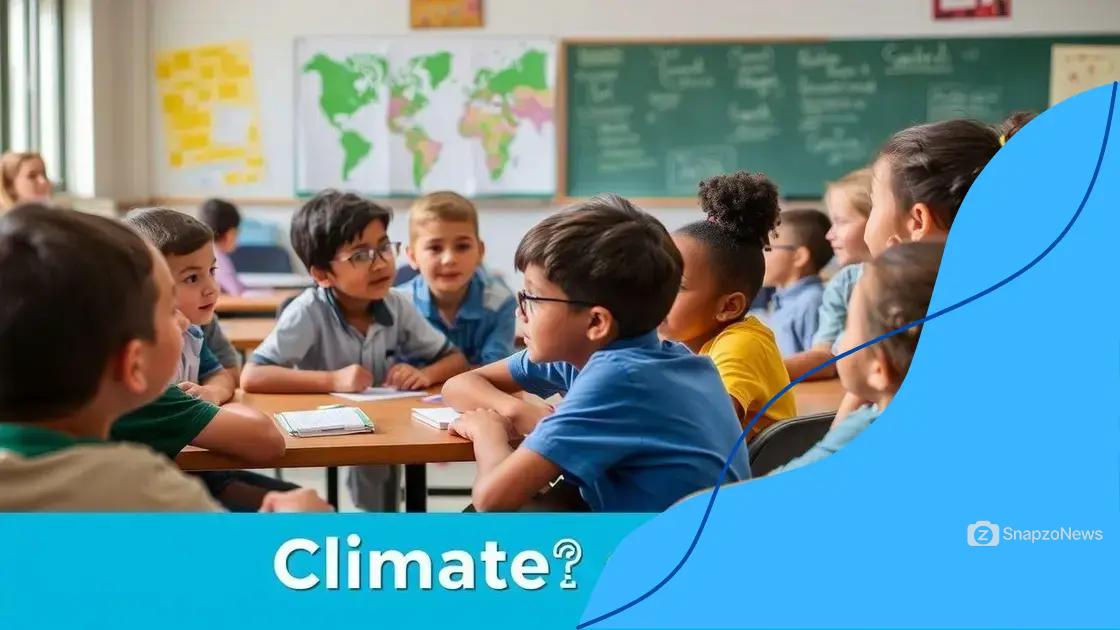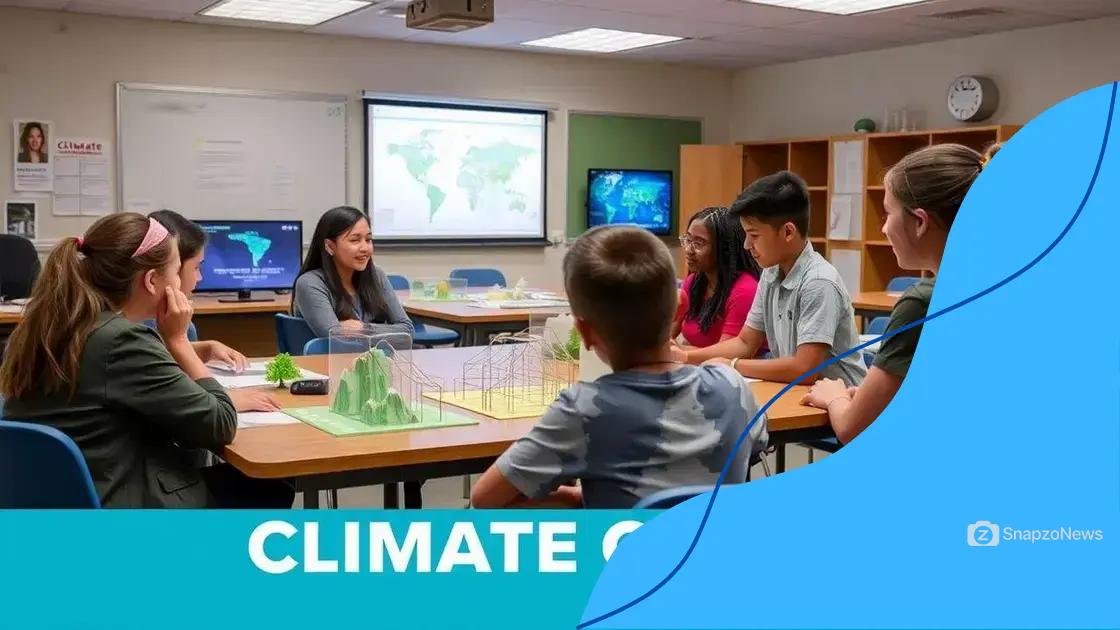Integrating climate change education into curricula for all

Integrating climate change education into curricula equips students with critical knowledge and skills to address environmental issues, fostering a sustainable future while overcoming challenges like resource limitations and resistance to change.
Integrating climate change education into curricula is essential in today’s rapidly changing world. How can we ensure that students understand and address these critical issues? Let’s explore the possibilities.
Understanding the impact of climate change
Understanding the impact of climate change is crucial for students today. This knowledge shapes their perspective on the environment and their role in it. Schools play an essential part in teaching about these pressing issues.
Effects on Environment
Climate change affects our planet in various ways, causing disruptions in ecosystems and weather patterns.
- Increased temperatures lead to abnormal weather.
- Extreme weather events, such as hurricanes, become more common.
- Species extinction is on the rise as habitats are destroyed.
Students must grasp these concepts to recognize their significance. When they learn about climate change, they understand how it impacts forests, oceans, and wildlife.
Societal Impacts
The effects of climate change are not limited to nature; they also influence human life. From economic to health aspects, understanding these effects helps prepare future generations.
- Food security can be threatened due to changing agricultural conditions.
- Health risks increase as climate-related diseases spread.
- Displacement occurs as communities are forced to leave their homes.
Addressing these challenges is imperative. Education not only raises awareness but also helps students develop solutions. They can become the leaders who tackle these critical issues.
Global Responsibility
Emphasizing a global perspective is vital. Climate change doesn’t affect everyone equally, and understanding these disparities can foster empathy and cooperation among students.
By integrating lessons on the impact of climate change, students learn the importance of global citizenship. They can appreciate diverse perspectives from different cultures.
Getting involved in local or global initiatives can inspire students to advocate for change. Being informed empowers them to make better decisions that benefit the planet.
Benefits of climate change education
Understanding the benefits of climate change education is vital for young learners. It equips them with the necessary tools to address environmental issues. By integrating this knowledge into the classroom, we can empower students to make informed decisions.
Awareness and Understanding
One major benefit is that students gain awareness of their surroundings. Learning about climate change helps them understand how daily actions affect the environment.
- Students learn the science behind climate change.
- Understanding the consequences fosters responsibility.
- They become aware of global challenges.
This awareness encourages critical thinking. It prepares them to engage in discussions about sustainability and environmental conservation.
Empowering Future Generations
Another significant advantage is empowerment. Climate change education inspires students to take action. They realize their choices can make a difference.
- Informed students can influence others.
- Empowering them fosters leadership skills.
- They are encouraged to participate in community initiatives.
When students feel empowered, they are more likely to pursue careers in environmental science and activism. This entry into the field shapes a better future.
Promoting Sustainability
Climate change education also promotes sustainability practices. Learning how to reduce waste and conserve energy leads to positive behavior changes.
As students adopt sustainable habits, they inspire peers and family members to do the same. This ripple effect extends far beyond the classroom, fostering a culture of sustainability.
Strategies for effective curriculum integration

Implementing strategies for effective curriculum integration is key to enhancing climate change education in schools. Teachers need to blend climate topics into various subjects, making learning both relevant and engaging.
Interdisciplinary Approach
One effective strategy is to adopt an interdisciplinary approach. This method weaves climate education into subjects like science, math, and social studies.
- In science, students explore ecosystems and environmental systems.
- Math can involve analyzing climate data and statistics.
- Social studies can address climate policy and its effects on different cultures.
This holistic view allows students to see the connections between disciplines and real-world applications. Such engagement fosters a deeper understanding of climate issues.
Project-Based Learning
Another impactful strategy is project-based learning (PBL). In PBL, students work on hands-on projects related to climate change.
- They can create models of renewable energy sources.
- Organizing community clean-up events helps them engage with real issues.
- Students can also research local environmental concerns and propose solutions.
This approach not only reinforces learning but also builds essential skills like teamwork, problem-solving, and communication.
Utilizing Technology
In today’s digital age, technology integration is vital. Utilizing technology tools enhances the learning experience and makes climate change education more accessible.
Interactive simulations and online resources can illustrate concepts effectively. Virtual field trips to ecosystems or climate action sites can provide immersive learning experiences. These resources help engage students and make complex topics easier to understand.
Examples of successful programs
Learning from examples of successful programs in climate change education can inspire schools to adopt similar initiatives. These programs demonstrate effective methods for teaching students about environmental issues while engaging them in meaningful ways.
Eco-Schools Program
The Eco-Schools program is an international initiative that promotes sustainability in schools. It encourages students to take an active role in their environment through hands-on projects.
- Students can start recycling programs at school.
- They learn about energy conservation by monitoring usage.
- Gardening projects help students connect with nature.
This program empowers students by involving them in decision-making processes. They gain practical skills while understanding their impact on the planet.
Climate Change Education Program (CCEP)
The Climate Change Education Program (CCEP) focuses on integrating climate science into various school subjects. It was developed to provide teachers with resources and training to effectively teach climate change.
- CCEP offers workshop sessions for teachers.
- It includes classroom materials like lesson plans and digital resources.
- Students engage in project-based learning to deepen their understanding.
This comprehensive approach ensures that students grasp the concept of climate change through different perspectives and subjects.
Green Schools Initiative
The Green Schools Initiative works at the community level to foster collaboration between schools and local organizations. It aims to create a sustainable learning environment throughout the community.
Through this initiative, students participate in community clean-ups and environmental awareness campaigns. They not only learn about the environment but also understand the importance of civic engagement.
These real-world applications help students realize their potential to enact change. Successful programs serve as powerful examples, showing how education can drive action and awareness regarding climate change.
Challenges in implementing climate change education
Implementing climate change education presents several challenges that schools and educators must navigate. Understanding these obstacles can help in developing effective strategies to overcome them.
Resistance to Change
One of the major challenges is resistance to change among teachers and administrators. Some educators may feel uncertain about introducing climate topics into their curriculum. They might lack confidence in their knowledge or skills related to climate science.
- Professional development is often needed to increase teacher comfort with the subject.
- Creating supportive networks can provide resources and encouragement.
- Incentives can motivate educators to embrace change.
Addressing these concerns is crucial for ensuring the successful integration of climate education.
Resource Limitations
Another significant barrier is limited resources. Many schools may not have the necessary materials, tools, or funding to implement effective climate change programs. This can hinder their ability to offer hands-on learning experiences.
- Schools need access to updated curriculum materials focused on climate issues.
- Funding for field trips and outdoor learning experiences is often lacking.
- Collaborations with environmental organizations can help provide needed resources.
Schools must seek out partnerships to enhance their educational offerings and overcome these limitations.
Curriculum Overload
Many educators face the challenge of curriculum overload. Teachers often struggle to fit climate change topics into an already packed schedule.
Incorporating climate education requires careful planning and alignment with existing standards. Finding time to explore these topics without sacrificing other essential subjects is critical. Adjusting curriculum frameworks to include climate change ensures that these discussions happen without overwhelming teachers or students.
FAQ – Frequently Asked Questions about Climate Change Education
What are the main benefits of integrating climate change education into the curriculum?
Integrating climate change education raises awareness, empowers students, and promotes sustainable practices, helping shape responsible future leaders.
What challenges do schools face when implementing climate change education?
Schools often encounter resistance to change, limited resources, and curriculum overload, which can hinder effective integration.
Can you give examples of successful climate change education programs?
Yes! Programs like Eco-Schools and Climate Change Education Program (CCEP) demonstrate effective strategies for engaging students in environmental issues.
How can teachers overcome the barriers to implementing climate change education?
Teachers can pursue professional development, seek partnerships for resources, and utilize project-based learning to make climate topics engaging and relevant.
